Roman fortune-telling was important in ancient society, connected to religion, politics, and everyday choices. Divination wasn’t just superstition; it was a respected practice used to understand the gods’ will and predict future events. Methods varied from interpreting bird movements to studying animal entrails, with each technique holding symbolic meaning and cultural significance.
Fortune-telling in Roman culture was deeply woven into rituals and state matters, affecting everything from military actions to personal decisions. The Romans thought these old divination methods could uncover hidden truths and help them make wise choices.
However, the dependence on such practices also showed the political instability and weak leadership that sometimes troubled the empire. This instability often drove people to desperate actions, including turning to fortune-telling for direction.
These divination methods weren’t only about individual choices; they also impacted significant government issues. For example, emperors frequently used coins as propaganda, embedding messages of power and legitimacy which were occasionally validated through divine interpretation.
Roman Fortune-Telling Techniques Still Used Today—Fact or Fiction? invites you to explore whether these ancient practices continue today or if they are purely part of myth and history. Are there traces of Roman divination in modern fortune-telling, or have these arts disappeared completely?
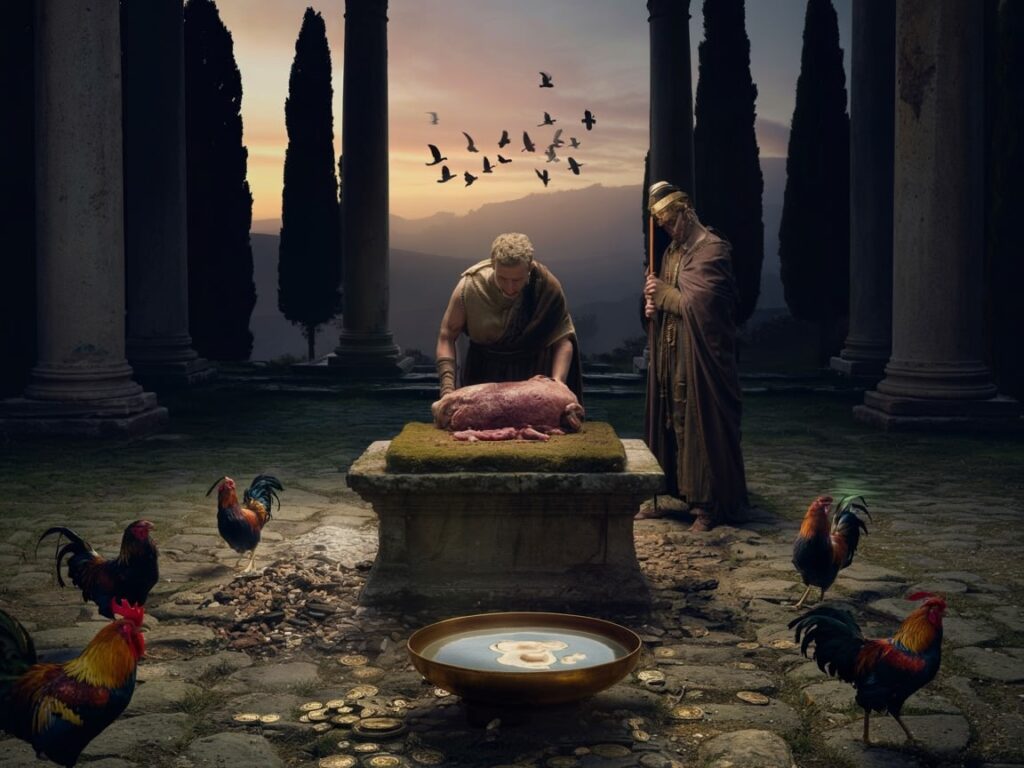
Historical Context of Roman Fortune-Telling Techniques
Fortune-telling was an important part of both Roman religion and everyday life. It was a key method for understanding ancient omens and played a significant role in shaping various aspects of Roman society.
Role of Fortune-Telling in Roman Society and Religion
Divination held great significance in Rome, serving as a vital means of connecting with the gods. Here are some key points about its role:
- Divination was considered an essential channel for communicating with the gods.
- Religious ceremonies often included rituals to seek approval or warnings from divine forces.
- Augurs—officials trained in interpreting bird flights—held significant influence over civic affairs.
Influence on Politics and Warfare
Fortune-telling had a direct impact on political decisions and military actions in ancient Rome. Here are some ways it influenced these areas:
- Political leaders consulted signs before passing laws or engaging in Senate debates.
- Military campaigns depended heavily on favorable omens; sacred chickens’ feeding behaviors could determine whether to advance or retreat.
- Ignoring unfavorable signs was sometimes seen as risking divine wrath and public disaster.
Cultural Exchanges Shaping Roman Practices
The Romans were known for their ability to adapt and incorporate customs from other cultures into their own practices. This is evident in the way they embraced divinatory traditions from various sources:
- The Romans absorbed divinatory customs from conquered peoples and trading partners.
- Practices like the use of Germanic runes found their way into Roman fortune-telling traditions, illustrating a blend of cultural influences.
- This syncretism enriched Roman divination methods, allowing for more complex interpretations and expanding the scope of ancient omens.
The integration of foreign techniques alongside indigenous practices reflects the adaptive nature of Roman fortune-telling. This historical context underscores how divination was not merely superstition but a structured system intertwined with religion, governance, and societal order. It served as a crucial element in maintaining the balance between these spheres, influencing everything from political decisions to artistic expressions that have left a lasting legacy.
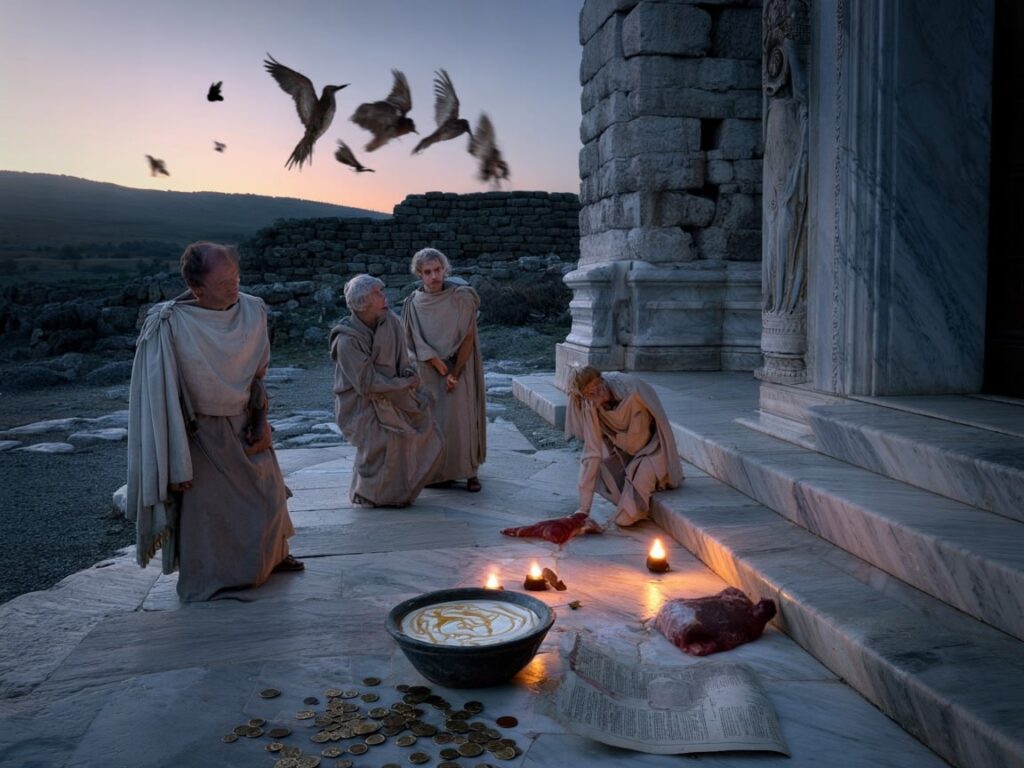
Key Roman Fortune-Telling Methods Explained
Roman divination featured a variety of distinctive techniques, many of which combined religious ritual with observation of natural phenomena. These methods shaped decisions in public and private life, reflecting a complex relationship between humans and the divine.
1. Augury
Augurs interpreted the flight patterns, songs, and behaviors of birds to forecast events. Sacred chickens played a crucial role — their eagerness to eat grain was seen as an auspicious sign before battles or political actions. A lack of appetite often meant withdrawal or caution was advised.
2. Haruspicy
This technique involved examining the entrails, especially the liver, of sacrificed animals. Haruspices looked for abnormalities or specific markings that indicated divine approval or warning. The liver was thought to be the seat of life and destiny, making it a prime source for omens.
3. Anthropomancy
Anthropomancy relied on interpreting signs from human sacrifice — including death throes and bodily reactions. Due to its brutal nature and growing ethical concerns, this method fell into disuse and was condemned by later Roman society.
4. Brontomancy
Thunder and lightning were considered messages from the gods. Brontomancers paid attention to the timing, frequency, and direction of these phenomena. Each day of the week had unique interpretations attached to such celestial events.
5. Oomancy
Egg whites were boiled and then observed for patterns formed inside cold water or on surfaces. Shapes resembling animals or symbols suggested future happenings, much like reading clouds or tea leaves.
6. Scrying
Reflective surfaces such as water pools or polished mirrors served as windows into visions or prophetic insights. Roman Emperor Didius Julianus reportedly consulted mirrors for guidance during uncertain times.
7. Alectryomancy
Roosters pecked at grains arranged in circles marked with letters or symbols. The sequence and number of pecks helped answer yes/no questions or predict outcomes.
8. Myomancy
Behavior of rodents like mice and rats was closely watched for signs of misfortune or disaster. Sudden movements, noises, or infestations carried specific superstitious meanings.
9. Urine Reading
Urine’s color, smell, taste, flow, and bubbles were analyzed not only for medical diagnosis but also as omens relating to health prospects and luck in personal affairs.
These diverse methods reflect how Romans sought divine communication through both nature and ritual acts—each carrying its own symbolism and cultural weight within Roman spirituality.
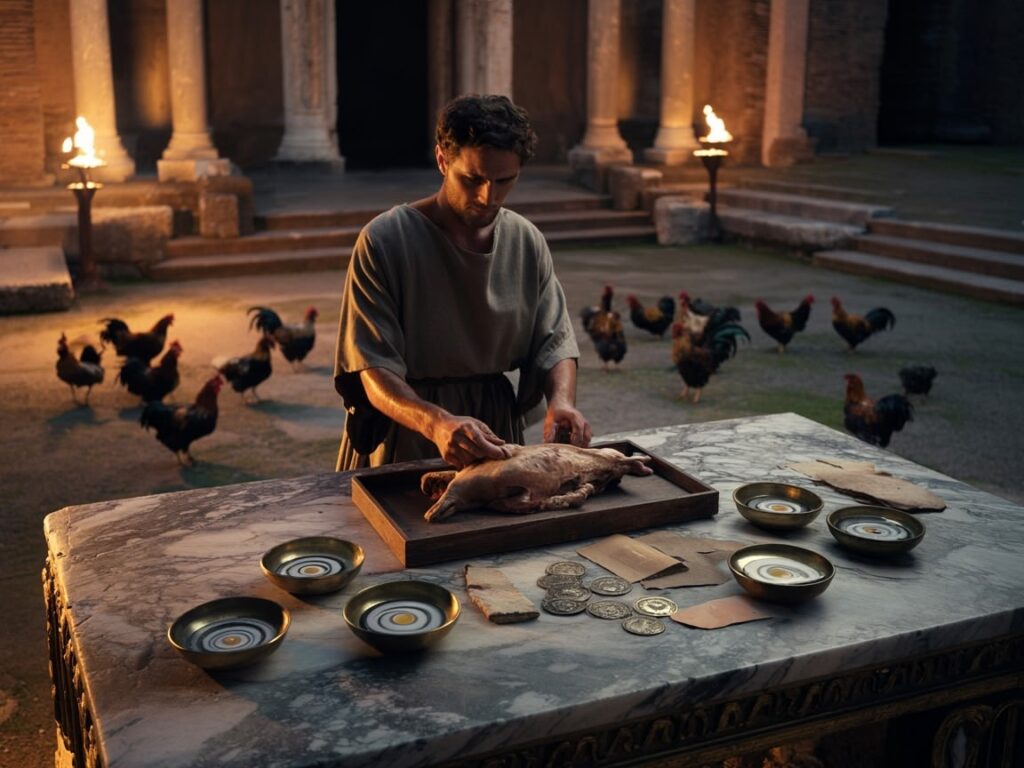
Techniques That Have Survived or Evolved into Modern Practices
Several Roman fortune-telling techniques have persisted or transformed into practices familiar in modern divination. These ancient methods laid the groundwork for how people today seek insight and guidance through spiritual and symbolic means.
1. Astrology
Astrology, deeply rooted in Roman prophecy and linked with the Sibylline Books, remains one of the most widespread forms of divination. The Romans integrated celestial observations into their religious and political decisions. Today’s horoscopes and natal charts trace their origins back to these early astrological systems, where planetary positions were believed to influence human affairs and natural phenomena.
2. Scrying
The Roman use of mirrors and other reflective surfaces for visions has evolved into contemporary scrying practices, notably crystal ball gazing. Modern occultists continue to use reflective objects as portals for receiving intuitive impressions or future glimpses. Scrying’s endurance highlights how symbolic tools can bridge ancient rituals with current mystical traditions.
3. Tasseography
Oomancy—the reading of patterns formed by egg whites—shares a conceptual similarity with tasseography, which interprets shapes in tea leaves or coffee grounds. This practice preserves the essence of pattern recognition in random natural formations, a technique that fascinated Romans and fascinates modern practitioners alike.
4. Palmistry
While not explicitly Roman in origin, palmistry absorbed influences from Roman-era divinatory traditions. The belief that hands reveal character traits and potential life events fits within the broader spectrum of ancient divination methods emphasizing physical signs as indicators of fate.
These enduring techniques demonstrate a clear lineage from Roman fortune-telling customs to present-day modern divination. They reflect how ancient spiritual tools adapt to changing cultural contexts while maintaining their core purpose: offering insight into the unknown.
However, it’s important to note that the influence of ancient Rome extends beyond just fortune-telling practices. The enduring legacy of Roman law has significantly shaped modern legal systems across the globe. Additionally, the evolution of Roman sculpture, which captured realism and power, reflects the cultural dynamics of ancient Rome. Furthermore, understanding the Roman Pantheon unveils insights into their gods associated with power, justice, and wisdom, further illustrating the depth of Roman influence on various aspects of modern society.
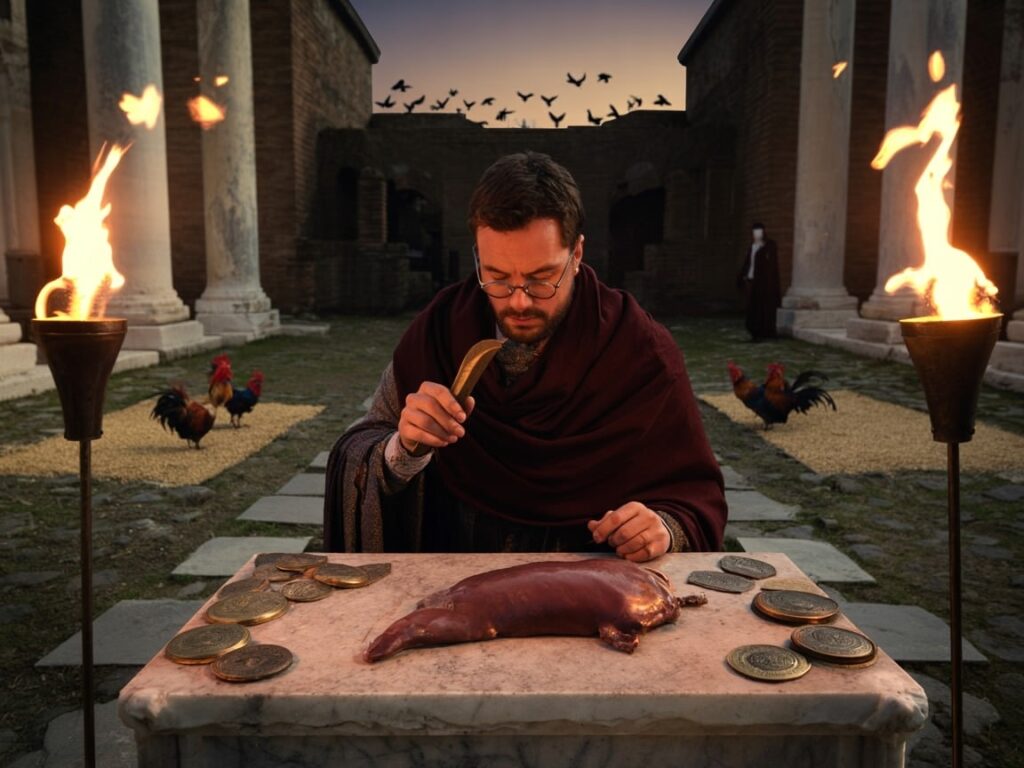
Techniques Largely Abandoned or Considered Mythical Today
Certain Roman divination methods have fallen completely out of favor, primarily due to ethical concerns and changing societal values. Anthropomancy, which involved interpreting omens from human sacrifice, is a prime example of a practice that was abandoned as moral standards evolved. The brutality inherent in this method made it unacceptable in later periods and it is now universally rejected.
Other techniques are often viewed as more symbolic or mythical rather than practical tools for prediction. These include:
- Myomancy: Interpreting the behavior of rodents like mice and rats to foretell events is largely dismissed today. It is regarded more as folklore than a reliable divination method.
- Alectryomancy: Using rooster pecking patterns to answer questions has lost credibility, often seen as superstition without scientific backing.
- Brontomancy: Divining by thunder and lightning remains a rare curiosity, its interpretations too vague and inconsistent for serious use.
The decline of these practices reflects a shift from literal belief in supernatural signs toward more symbolic or psychological interpretations within modern spirituality. Many are preserved only in stories or cultural references rather than active fortune-telling traditions.
Ethical evolution and rational scrutiny have relegated these methods mostly to historical interest rather than credible predictive arts, distinguishing them clearly from those that adapted into contemporary practices.

Influence of Cross-Cultural Exchanges on Roman Divination and Its Legacy
Roman divination practices did not develop in isolation. The empire’s vast reach and interactions with diverse cultures created a rich tapestry of cultural influence that shaped its fortune-telling traditions.
1. Adoption of Germanic Runes
Romans encountered Germanic tribes who used runes as a form of divination and writing. Some scholars suggest the symbolic use of runes influenced Roman occultism, contributing to the development of esoteric alphabets and mystical symbols within Roman and later Western magical traditions.
2. Sibylline Books
These prophetic texts were central to Roman religion and decision-making. Originating from Greek and possibly Etruscan sources, the Sibylline Books exemplify how Romans integrated foreign oracular knowledge. The books guided political leaders during crises, showing how divination was institutionalized and respected at the highest levels.
3. Longevity of Techniques
Cultural exchange helped preserve certain methods by blending them with local customs. For example, astrology’s roots in Babylonian and Hellenistic traditions were embraced by Romans, embedding celestial divination deeply into Western esotericism.
4. Legacy on Western Esoteric Traditions
Many modern occult practices trace their lineage back to this blend of Roman techniques combined with imported beliefs. Crystal ball gazing (scrying) and tarot symbolism reveal influences from these cross-cultural encounters, confirming that ancient Roman divination forms a foundational layer for contemporary spiritual arts.
This fusion shows how foreign ideas were not only absorbed but transformed within Roman fortune-telling frameworks, enriching their complexity and ensuring their survival well beyond the empire’s fall. The impact of Roman society on Western civilization is evident in various aspects of modern life, including our understanding and practice of divination.
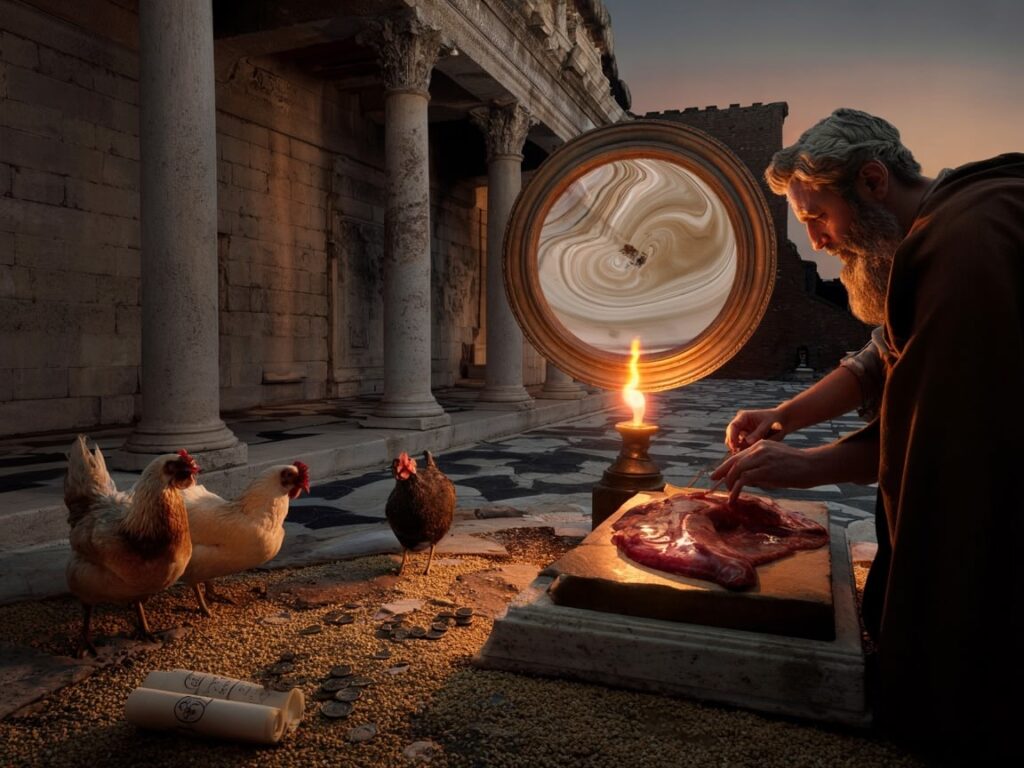
Fact or Fiction? Evaluating the Authenticity and Effectiveness of These Techniques Today
The question of divination accuracy remains central when exploring Roman fortune-telling techniques still used today—fact or fiction? Many ancient methods lack scientific validation, prompting skepticism among modern scholars and practitioners. Yet, belief in these techniques persists, often grounded in psychological and cultural frameworks rather than empirical proof.
Psychological Factors Behind Continued Belief
Confirmation bias leads individuals to remember successful predictions while discounting failures. The Barnum effect explains why vague or general statements feel personally relevant during readings. Engaging in divination can offer comfort, reduce anxiety, and provide a sense of control over uncertain futures.
Cultural Belief Systems and Spiritual Practices
Divination often fulfills social and religious roles beyond mere prediction, embedding itself into community rituals. Modern spiritual practitioners may adopt adapted forms of Roman methods such as scrying or tasseography as tools for introspection, guidance, or meditation. The symbolic language of these techniques resonates with people seeking connection to ancient wisdom or alternative worldviews.
Credibility Today
Skepticism arises from the absence of reproducible results under controlled conditions. Scientific inquiry demands measurable outcomes, yet many divinatory practices operate within subjective experience. This gap fuels ongoing debate about their legitimacy. As discussed in this paper, understanding the interplay between belief, tradition, and evidence helps explain why some Roman fortune-telling methods survive while others fade into myth.
“Divination’s value may lie less in forecasting the future and more in facilitating personal insight and cultural continuity.”
Conclusion
The legacy of Roman fortune-telling techniques reveals a fascinating blend of ancient wisdom and cultural storytelling that still captures imaginations today. These methods, while lacking scientific validation, hold undeniable importance in understanding how ancient societies sought guidance and meaning. Their symbolism and ritualistic aspects continue to influence modern spirituality, reflecting humanity’s timeless desire to connect with the unknown.
However, to fully appreciate these techniques, one must also consider the broader context of Trade and Economy in Ancient Rome. The economic practices of this era shaped not only its vast empire but also the daily lives of its people, influencing various aspects including their spiritual beliefs and practices.
You are encouraged to:
- Explore both historical divination practices and their modern counterparts.
- Approach these arts with curiosity balanced by critical thinking.
- Recognize the value in cultural heritage alongside rational inquiry.
Roman fortune-telling techniques remain a compelling chapter in the story of human belief systems—fact or fiction? The answer lies in your personal journey through the rich tapestry of mystical traditions. Keep an open but discerning mind as you delve deeper into this intriguing world.
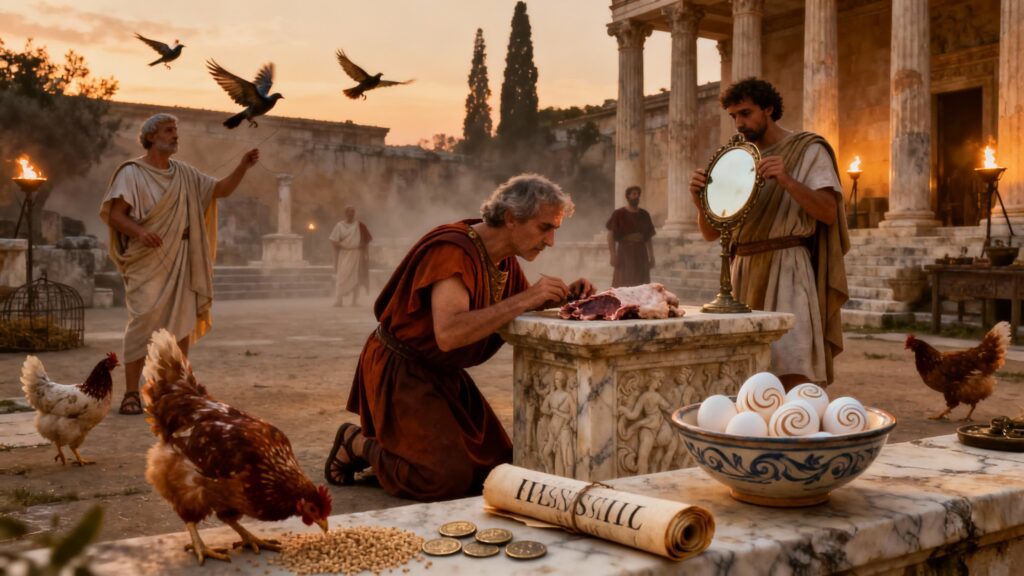
FAQs (Frequently Asked Questions)
What were the main fortune-telling techniques used in ancient Roman culture?
Ancient Roman fortune-telling techniques included augury (interpreting birds and sacred chickens), haruspicy (examining the livers of sacrificed animals), anthropomancy (human sacrifice, now disused due to ethical concerns), brontomancy (interpreting thunder and lightning), oomancy (reading egg whites patterns), scrying (using mirrors and reflective surfaces), alectryomancy (observing rooster pecking patterns), myomancy (interpreting rodent behavior), and urine reading for omens related to health and luck.
How did divination influence Roman society and decision-making?
Divination played a crucial role in Roman religion and daily life, influencing decisions from politics to warfare. Romans relied on interpreting omens and signs through various fortune-telling methods to guide actions, reflecting the deep integration of divination in their cultural and religious practices.
Are any ancient Roman fortune-telling techniques still practiced or evolved into modern forms today?
Yes, several ancient Roman divination methods have survived or evolved into modern practices. Astrology has roots linked with Roman prophecy and the Sibylline Books. Scrying has evolved into crystal ball gazing and mirror use in contemporary occultism. Oomancy parallels tasseography, such as reading tea leaves or coffee grounds. Palmistry also reflects broader divinatory traditions influenced by Roman-era beliefs.
Why are some Roman fortune-telling methods like anthropomancy no longer practiced today?
Practices such as anthropomancy, which involved human sacrifice for divination, have been abandoned due to moral and ethical standards. Modern societies consider such methods unethical and often regard them as symbolic or mythical rather than factual predictors.
How did cross-cultural exchanges impact Roman divination techniques?
Romans incorporated foreign divination methods through cultural exchanges, such as Germanic runes influencing their practices. The Sibylline Books also contributed to their prophetic traditions. These interactions enriched Roman divination, impacting the longevity of specific techniques and shaping Western esoteric traditions.
What is the modern perspective on the authenticity and effectiveness of ancient Roman fortune-telling techniques?
Contemporary views vary; some regard these ancient methods as culturally significant but lacking scientific validity. Psychological and cultural factors contribute to continued belief or skepticism. While many see them as part of spiritual practices today, their accuracy remains debated, blending historical fascination with modern spiritual exploration.

